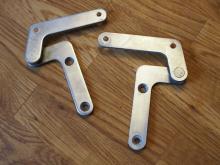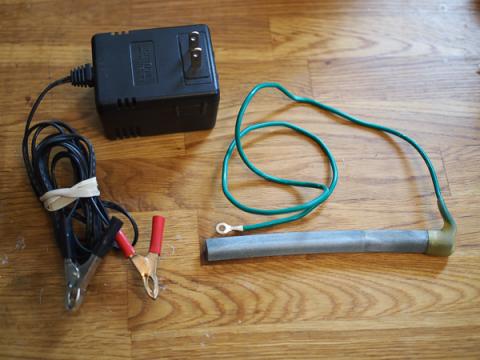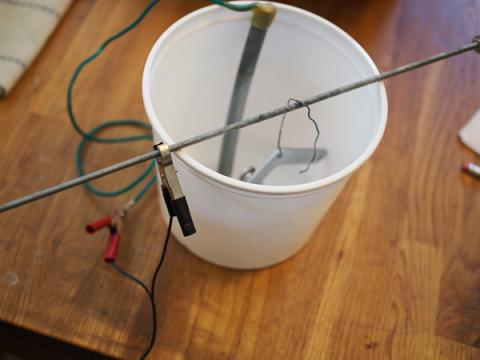I have a very simple home electroplating setup that i use to replate small parts. There are certainly better ways to do this (a proper power supply, for one), but this is cheap and easy to pack up for storage.
Seat headrest hinges, before and after replating:
Zinc isn't the most durable metal finish, but it does give old parts a nice shine, and is really easy to do for small parts. You can find better tutorials and more info on finishes like yellow chromate that is common on car parts.
Parts needed
- small power supply (typical wall wart, producing around 500mA)
- zinc anode (the style used in swamp coolers works well)
- small plastic bucket
- metal rod
- clips and wire
- brass brush
Solution recipe
- 1.5 liters water
- 50ml vinegar
- 75 grams Epsom salts
- 50 grams zinc sulfate (available online)
- 2 Tbsp corn syrup (makes for smaller crystals and smoother plating)
Setup
If you're using a standard wall wart-style power supply, cut off the plug and make it easy on yourself by putting some large clips on instead of bare wires. The one marked with a stripe will be positive, plain one negative. If you're using a variable power supply, good on ya.
Mix the solution in the plastic bucket.
Make sure the parts you're plating are as clean as they can be: no rust or paint, and degreased.
Arrange the parts in the bucket, hanging them from the rod with wire. Make sure there's an electrical connection from the parts to the rod, and enough space in the bucket to move parts around as needed to plate all sides. Make sure the anode and the parts aren't touching!
Plating parts
Connect the positive side of the power supply to the anode and the negative side to the rod holding the parts. You may get some small sparks.
You should see small bubbles forming around the part within a minute or so. The parts should get a dusty-looking blue-gray coating within a few minutes. When fully covered, remove the parts and brush them off, rinsing with water. This is called striking the part, and helps develop an even coating. Return the parts to the bath 2-3 more times for additional coating.
Turn or re-arrange parts in the bath to make sure all sides get plated. Think about the plating action like a paint spray: it will coat best on the side facing the anode. You should get an even plate over the whole part. If an area is stained or shows uneven plating, sand or wire brush and degrease again, then try plating again.
When done, brush off the gray coating with the brass brush, wash and polish.
Here's a seat latch part, showing the original finish on the back, and the fresh coat of zinc on the front.
More Info & Troubleshooting
General rule of thumb is to use about 65 mA per square inch of part to plate. If you're using a fixed size power supply, you'll notice a big difference in the bubbling action between large and small parts. If you have enough space, you can smooth this out by doing several small parts together.
If the current is too high for the part, the bubbling action will be very strong and you the coating will be dark gray and fuzzy-looking. This can make for uneven color in the plating. Use a smaller amount of current (different supply) or add more parts to the bath.





